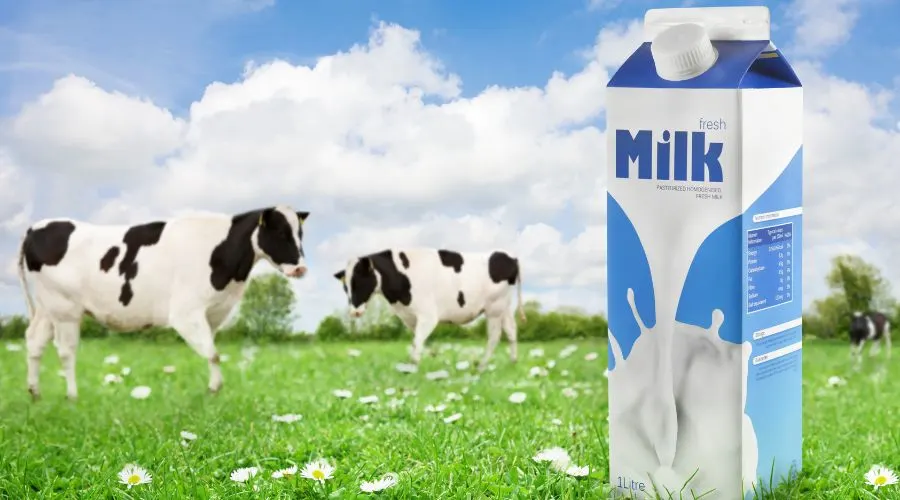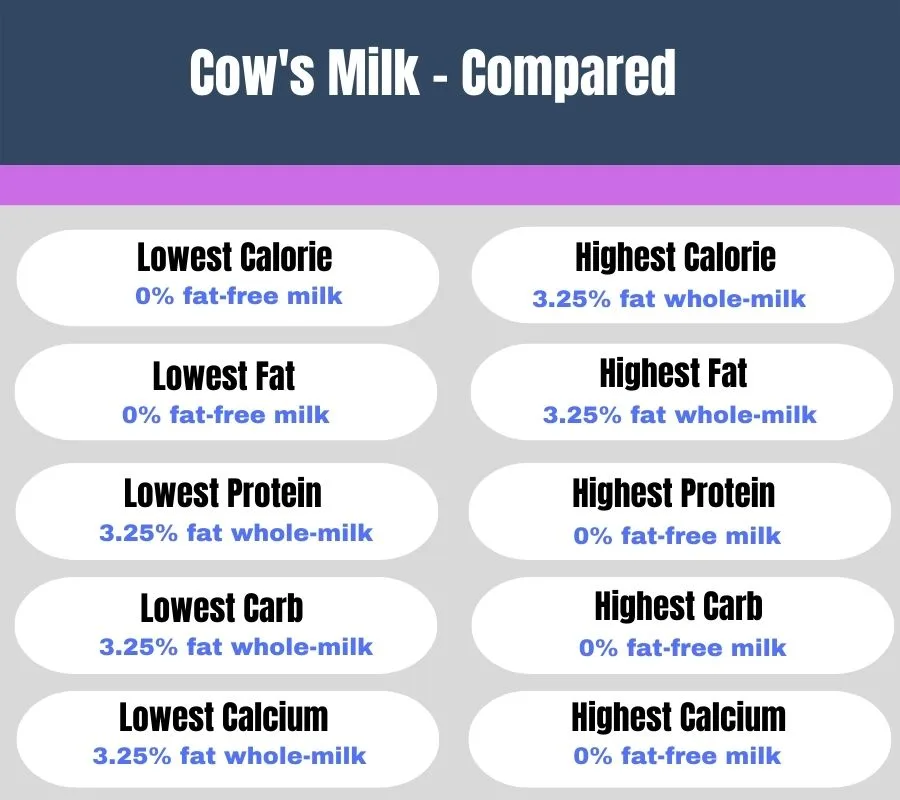Everyone has their favorite kind of milk, whether it’s low-fat and light or high-fat and creamy, but many don’t stop to think about the difference between them.
If you’re following a low-calorie diet or you’re trying to reduce the amount of fat you consume, changing your milk might make a difference, but is it worth it, and how much difference will changing really make?
In this article, we have all the information you need to make an informed choice on which milk is best for you and your diet. With a complete comparison between various types of cow’s milk, including calorie, fat, carbs, protein, and calcium content.

Information In This Article
Use the links below to skip to the section you need:
- Cows milk calorie comparison – including milk calorie calculator
- Cows milk fat comparison
- Cows milk protein comparison
- Cows milk carbohydrate & sugar comparison
- Cows milk calcium comparison
Cows Milk Calorie Comparison
A serving of cow’s milk is one cup, which converts to 240ml or 8.4 fl oz. The lowest-calorie cow’s milk per serving is 0% fat-free skim milk which contains 82kcal per cup, compared to whole (or full-fat) milk which contains 146kcal per serving.
This is a 64-calorie difference between fat-free milk and whole milk (per cup). There’s a difference of 17kcal between 1% fat milk and 2% and 1% milk contains 21 more calories per cup than fat-free milk.
If you prefer your milk a little creamier, the good news is that if you drink it in moderation, there’s not too much difference between fat-free and 1% or 2% milk.
| Milk Type | Calories Per 100g | Calories Per Cup (240ml/8.4fl oz) |
| 0% Fat-Free Skim Cows Milk | 34kcal | 82kcal |
| 1% Fat Cows Milk | 43kcal | 103kcal |
| 2% Fat Cows Milk | 50kcal | 120kcal |
| 3.25% Fat Whole Cows Milk | 61kcal | 146kcal |
Milk Calorie Calculator (For All Types)
If you need to work out how many calories are in your serving of milk, you can use the calculator below to find the information you need.
This calculator will work for any milk type (including milk alternatives) and any amount. Choose your milk and measurement type to continue:
Cows Milk Fat Comparison
Each kind of milk has a varying fat content to allow consumers to make a choice on which is healthiest for their diet and which they like the most.
It goes without saying that whole cow’s milk has more fat than the fat-free alternative, but let’s take a look at the difference.
Whole milk contains 4.49g more fat per cup than fat-free milk, most of which is saturated fat.
If you opt for 1% or 2% fat milk over whole milk you can make a saving on the amount of saturated fat per serving of around one-half.
| Milk Type | Total Fat Per Cup (240ml/8.4fl oz) | Saturated Fat Per Serving |
| 0% Fat-Free Skim Cows Milk | 0.19g | 0.12g |
| 1% Fat Cows Milk | 2.28g | 1.36g |
| 2% Fat Cows Milk | 4.56g | 2.66g |
| 3.25% Fat Whole Cows Milk | 4.68g | 4.46g |
Harvard Health Publishing has a useful calculation to help you work out the maximum amount of saturated fat you should be consuming per day.
Cows Milk Protein Comparison
Cows milk is an excellent source of protein and the lower the fat content, the higher the protein content, however it’s important to point out the difference is small.
Although whole milk is lower in protein, it still contains 7.85g per cup, which is only 0.38g less than fat-free milk.
| Milk Type | Protein Per 100g | Protein Per Cup (240ml/8.4fl oz) |
| 0% Fat-Free Skim Cows Milk | 3.43g | 8.23g |
| 1% Fat Cows Milk | 3.38g | 8.11g |
| 2% Fat Cows Milk | 3.36g | 8.06g |
| 3.25% Fat Whole Cows Milk | 3.27g | 7.85g |
Cows Milk Carbohydrate Comparison
When it comes to carbohydrate content in cow’s milk, the higher the fat content the lower the carbohydrate content, however, the difference is very small.
All kinds of cow’s milk contain about 11g of carbohydrates per cup, but fat-free milk contains 0.69g more carbohydrates per serving than whole milk.
| Milk Type | Carbohydrate Content Per 100g | Carbohydrate Content Per Cup (240ml/8.4fl oz) |
| 0% Fat-Free Skim Cows Milk | 4.92g | 11.8g |
| 1% Fat Cows Milk | 4.9g | 11.76g |
| 2% Fat Cows Milk | 4.9g | 11.76g |
| 3.25% Fat Whole Cows Milk | 4.63g | 11.11g |

Cows Milk Sugar Comparison
Milk is fairly high in naturally occurring sugars and the lower the fat, the higher the sugar content, although the difference is fairly small.
All kinds of cow’s milk contain 11-12g of natural sugars per cup, however, fat-free skim milk contains 0.58g more sugar than whole milk.
| Milk Type | Sugar Content Per 100g | Sugar Content Per Cup (240ml/8.4fl oz) |
| 0% Fat-Free Skim Cows Milk | 5.05g | 12.12g |
| 1% Fat Cows Milk | 4.96g | 11.9g |
| 2% Fat Cows Milk | 4.89g | 11.74g |
| 3.25% Fat Whole Cows Milk | 4.81g | 11.54g |
Cows Milk Calcium Comparison
Cow’s milk is known for its high calcium content, but does one kind of milk contain more calcium than another?
The quick answer is that the lower fat the milk, the higher the calcium content, although it’s important to note that the difference is small.
One cup of fat-free cow’s milk contains 22mg less calcium than whole milk, with 1% and 2% milk both containing the same amount of calcium per serving.
You can find out how much calcium you need per day in this Mayo Clinic article.
| Milk Type | Calcium Content Per 100g | Calcium Content Per Cup (240ml/8.4fl oz) |
| 0% Fat-Free Skim Cows Milk | 132mg | 317mg |
| 1% Fat Cows Milk | 126mg | 302mg |
| 2% Fat Cows Milk | 126mg | 302mg |
| 3.25% Fat Whole Cows Milk | 123mg | 295mg |
Key Takeaways
The comparison above shows that there are some benefits to consuming higher-fat milk, but there are also some negatives as well. Ultimately, which is best for you is dependent on your dietary requirements, but here’s a summary of the key takeaways to help you decide:
- The lower the fat content in milk, the lower the calories, but there’s not much difference between fat-free skim, 1%, and 2% if you prefer your milk a little creamier.
- Whole milk contains three times the amount of fat of 1% milk and nearly double the fat of 2% milk – most of which is saturated fat.
- There’s slightly more protein in skim milk than there is in whole milk.
- Higher-fat milk is slightly lower in carbohydrates and natural sugars than skim milk.
- Lower-fat milk contains slightly more calcium per serving, although it’s important to note that all milk is a good source of calcium.
More Cows Milk Comparison FAQs
Each kind of milk comes with its own health benefits, for example, fat-free skim milk is lower in saturated fat, and it’s higher in protein and calcium, however, whole milk is lower in natural sugars.
Cow’s milk is fairly high in carbohydrates due to its natural sugar content. There’s little difference between the carbohydrate content in various kinds of cow’s milk, but the higher the fat content, the lower the carb and sugar content.
More Milk-Related Articles
This page is part of a series of helpful articles related to milk weights, servings, and conversions, the links below will take you to the other articles in this series:
Lowest calorie milk (with milk alternatives & calculator)
Milk Calorie Calculator (for any serving & various types)
How Many Calories Are In Oat Milk?
References Used for this Article
To ensure the nutritional information used in this article is accurate, I have used data from USDA; the link below contains the source information:
Fat-free milk nutritional information
1% skim milk nutritional information
